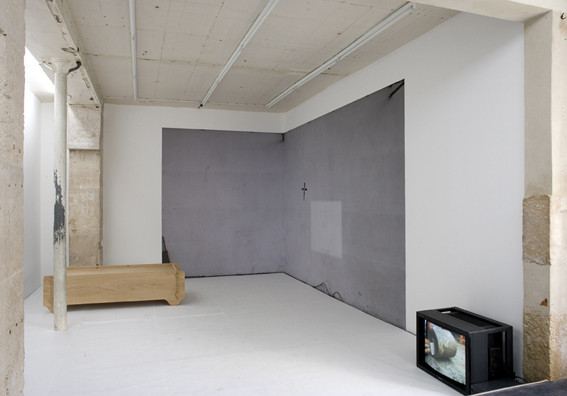Guillaume Leblon
17 Nov - 22 Dec 2007
GUILLAUME LEBLON
"Rupture de correspondances"
Rupture de correspondances emerged from a way of arranging and condensing the landscape, the art studio, the gallery: three places and three moments that interest Guillaume Leblon in his thinking about the hierarchical process inherent to artistic production. Here, oak is transformed into a piece of hybrid furniture, somewhat resembling a cradle, a table, a bed and an over-turned cabinet (Meuble, oak, 2007). This chest, into which the entire exhibit could be placed, is neither glued nor drilled, but assembled with pegs. On the monitor, Notes (video, 7:22 min) seizes the landscape as it infiltrates the studio, which was overrun with clay and water for many days. Hands and feet are plunged into the mud and into the landscape’s buried memory. Puits (uncooked clay, 2007), an arrangement of hand-made clay bricks, forms a kind of section of a well or chimney. This sketch (the clay is not cooked) perfectly balances the image (the result) and the material (the starting point). In the same logic, the two Frame of a Window (glass, 2007), thin strips of glass leaning against the wall, are cut to their maximum lengths, that is, before the material collapses under its own weight. These lines of glass function equally well as units of measurement (perhaps taken from the art studio) or laboratory tools or scraps from some invisible window. Placed in an angle of the gallery, Studio visit (digital print, glue, 2007), an entire wall from the artist’s studio, photographed and reproduced in black and white at a scale of 1 on large parcels of paper, intervenes like a kind of graft in the gallery. The cut is clean, but the image’s variations in light play with the irregularities of its medium. The digital grain of this “wall paper” dissolves into the space, the air, the ambient light and the floor where long strips of architect paper have been unrolled. This “ghost carpet” paradoxically reflects the exhibition space in its entirety and lights up the space’s multiple tones of white, off-white, or crème colors on the walls, columns and ceiling. Each work is alternatively a drawing, a model, a figure, an image, or a ruin. The relationships established between the viewer and the works continually alter in status. The organization of the material and the archetypal figures of habitat (wall, floor, furniture, window, garden) disturb the hierarchy between the finished object and its beginning stages, between the craft industry and the do-it-yourself project, and between the heritage of older shapes and the raw freshness of new materials.
"Rupture de correspondances"
Rupture de correspondances emerged from a way of arranging and condensing the landscape, the art studio, the gallery: three places and three moments that interest Guillaume Leblon in his thinking about the hierarchical process inherent to artistic production. Here, oak is transformed into a piece of hybrid furniture, somewhat resembling a cradle, a table, a bed and an over-turned cabinet (Meuble, oak, 2007). This chest, into which the entire exhibit could be placed, is neither glued nor drilled, but assembled with pegs. On the monitor, Notes (video, 7:22 min) seizes the landscape as it infiltrates the studio, which was overrun with clay and water for many days. Hands and feet are plunged into the mud and into the landscape’s buried memory. Puits (uncooked clay, 2007), an arrangement of hand-made clay bricks, forms a kind of section of a well or chimney. This sketch (the clay is not cooked) perfectly balances the image (the result) and the material (the starting point). In the same logic, the two Frame of a Window (glass, 2007), thin strips of glass leaning against the wall, are cut to their maximum lengths, that is, before the material collapses under its own weight. These lines of glass function equally well as units of measurement (perhaps taken from the art studio) or laboratory tools or scraps from some invisible window. Placed in an angle of the gallery, Studio visit (digital print, glue, 2007), an entire wall from the artist’s studio, photographed and reproduced in black and white at a scale of 1 on large parcels of paper, intervenes like a kind of graft in the gallery. The cut is clean, but the image’s variations in light play with the irregularities of its medium. The digital grain of this “wall paper” dissolves into the space, the air, the ambient light and the floor where long strips of architect paper have been unrolled. This “ghost carpet” paradoxically reflects the exhibition space in its entirety and lights up the space’s multiple tones of white, off-white, or crème colors on the walls, columns and ceiling. Each work is alternatively a drawing, a model, a figure, an image, or a ruin. The relationships established between the viewer and the works continually alter in status. The organization of the material and the archetypal figures of habitat (wall, floor, furniture, window, garden) disturb the hierarchy between the finished object and its beginning stages, between the craft industry and the do-it-yourself project, and between the heritage of older shapes and the raw freshness of new materials.

